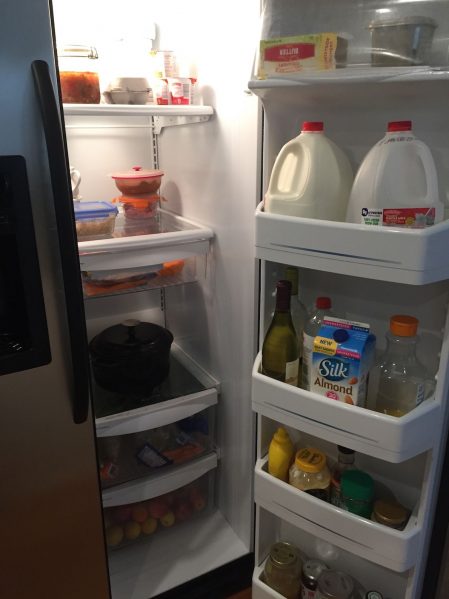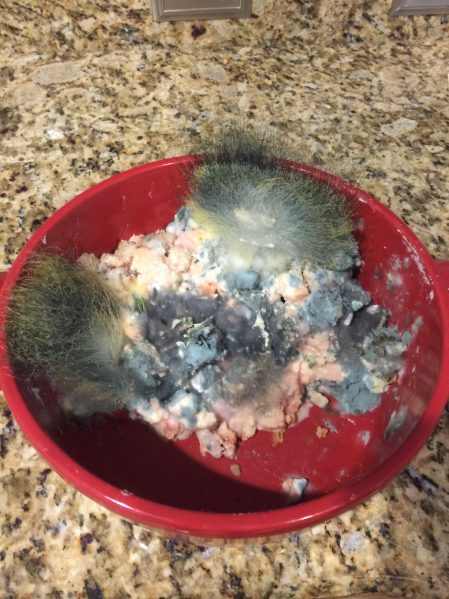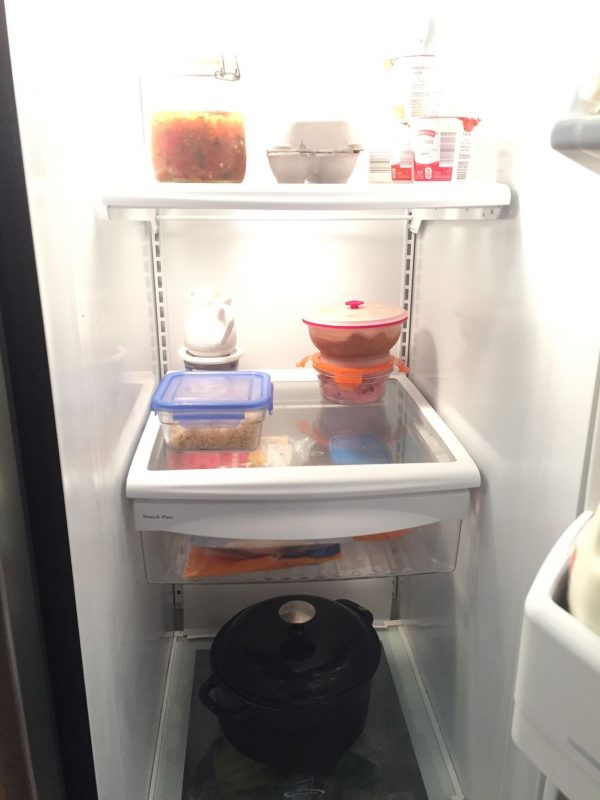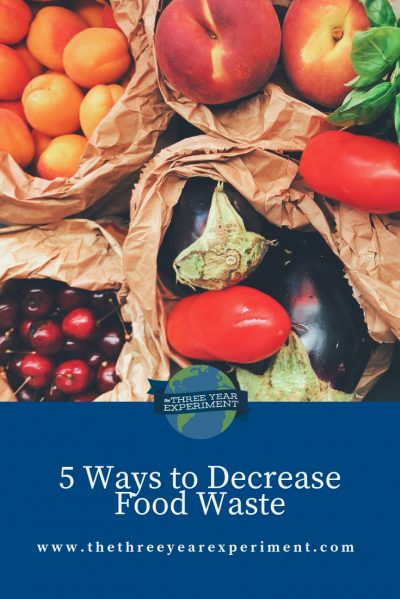Last week, I read not one, but two articles on the top ways we, as ordinary people, could help decrease global warming.
Boy, was I surprised to learn that the NUMBER THREE thing we could do was decrease our food waste. I’m a big fan of composting, but according to Project Drawdown, an organization that ranked the top ways we can mitigate the effects of global warming, composting is only the 60th best method for solving the problem.
It turns out that paying attention to how much food we waste is a much better way of helping the planet, as composting can give you a false sense of doing good while still letting you chuck a good bit of food waste into the bin.
I’ve followed YouTuber Debt Kickin’ Mom for awhile, and I’m always inspired by her videos of her ZeroWaste food plan for her family of six. Basically, she buys just enough to last her family for the week, with only a few leftovers. She even tries to eat up everything in her freezer in a week or two, which apparently is a really smart strategy, as people throw a ton of frozen-over freezer goods out after they’ve been sitting in the back of the freezer for six months (guilty on that front! So guilty!).
I’m going to be completing a challenge to drastically decrease our food waste this month, so in the spirit of getting ready for that, here are some ways that I’ve researched and implemented in the past to decrease our food waste.
Inventory Once per Week
Without a doubt, the number one way that we keep our food waste down is when I do a food inventory before I go to the grocery store.
Here’s a common problem: we overbuy at the grocery store. Waaay overbuy. So I’ll go to the store and get our “necessities” when the fridge and pantry are still chock-full of food.
One way I’ve found to counter-act this tendency is to do a food inventory. It doesn’t take long. All I do is open the fridge and do a quick run-down of the food we have as I’m writing my grocery list. Half gallon of milk? Okay, we need two more. Six lemons, two limes? Good on citrus. Half a head of cabbage? We need to eat that for dinner within the next three days. Flacid celery? I should make chicken soup tomorrow to use that up (soup is a really good way to use up the random meats and veggies from the fridge).
I do the same in the freezer. If we have two leftover tilapia filets, I figure out a meal to use them up that week. We almost never have leftover meat in the freezer at the end of the week, as I just buy enough for the week, but if we do, then I make sure to use it for the following week so it doesn’t start to get freezer burn.
Finally, I hit the pantry to see what staples we have that I can use to make meals for the following week. Two cans of coconut milk and lots of rice? I should make a chicken curry. Half a box of pasta? I need to buy the same kind at the store and plan a pasta dish.

When I do a good job of taking inventory, then I do a more efficient and less-wasteful job of buying at the store.
Keep a Leftover Bag in the Freezer
This is one of the best tips I’ve ever found for using leftover veggies. My grandmother taught me this trick right after I first got married. She told me to keep a Ziploc bag in the freezer and put all of my leftover celery stems, onion peels, and carrot bottoms into it, as well as my chicken bones, to make broth. (You could also add ham scraps or beef as well).
When the bag gets about halfway to three-quarters full, I have enough to make broth. I just toss all the frozen stuff in a pot, add water and salt, and let it simmer on medium-low heat for about half an hour. Then I drain the veggies (and put them in the garbage disposal or compost) and have the most delicious broth I can use for soups. Yes, I’m still getting rid of the scraps at the end of it, but I’ve used them to flavor soups before tossing them, and therefore don’t need to buy broth from the store.
You can also keep a leftover bag of cooked beans, green beans, corn, or other bits of leftovers to make vegetable soup. You’ll just add a ham bone to the contents of your bag and you have a delicious veggie soup. It does take a bit of trial and error to figure out what to put in the leftover bag, but in general, it’s a way to help you preserve the spoonful of beans or few lone carrots left after a meal.
Embrace an Empty Fridge
This tip has been one of the hardest for my family. Mr. ThreeYear hates, and I mean, hates, to have an empty fridge. It seems to trigger a fear in him from childhood that he’s not going to have enough to eat.
I, on the other hand, have anxiety when the fridge is too full. It makes me feel like we’re not going to possibly be able to eat all of the food and are going to waste it, something that I abhor. So, we have a bit of a dance with our fridge. It can’t be too empty or too full.
For normal people without all kinds of weird issues around the fullness of their fridge, however, may I recommend embracing an empty fridge. If your fridge is almost empty at the end of the week, it means you’ve done a great job buying the right amount of food for your family.
The truth is, our fridges don’t need to be stuffed to the gills with 13 different types of salad dressings, condiments and sauces galore. It just encourages us to waste them. We keep two types of salad dressing in the door, both homemade, and just a few basic condiments (regular mustard, dijon, mayonnaise, ketchup). If we need anything else, like BBQ sauce, we make it. This works well for our family, because it teaches us that we should be using (and using up) everything in our fridge on the regular.
We try to get the boys to eat up all the fruit we buy each week. We usually end the week with just three or four apples left, and perhaps a couple of lemons or limes. Everything else has been eaten. We tend to have a few more vegetables, because it takes us more than one week to go through a bag of carrots or celery. But we limit the amount of fruit and veggies we buy to about 3-4 types per week. We may not always buy lettuce and tomatoes for salad, especially in winter. Sometimes, we’ll just stick to broccoli and cauliflower, and roast it. Then, we’ll buy salad stuff the next week.
I also make sure that we actively plan to eat our leftovers for lunch. If there’s something that no one’s eating (currently some leftover hamburger patties), then Mom eats those for lunch.

I’m not always great about finishing up the leftovers, and this tends to be the biggest place we waste food. I’ll let a quarter of a cabbage go bad, or forget about some old leftovers.
I’ve read that lots of people treat produce in the fridge as “must eat.” They do a daily check of the food in their fridge, and if something looks like it’s about to go bad, they eat it that day.
Your Nose Knows
Don’t, for the love of Pete, throw away a food just because the “Best By” date has passed. What, do you think the people who make the food have some fancy scientific method for ensuring their food is going to go bad exactly at that date? They don’t. They’re guessing.
The very best way to test if something is still good is to stick your nose in it. If milk is bad, you can smell it. You can also get to the point where you smell when it’s about to go bad but still has a day or two left. If the meat is no longer good, you will know. It will smell horrible.
Unless something has been sitting in the back of the fridge for a month, go ahead and do the smell test before you chuck it. Chances are, it will be fine. Our refrigerators keep food cold enough, especially in the back of the fridge, that they will last a loooong time. Don’t be afraid of your food. If it has been kept in cold storage (and especially if it has been pasteurized), it will last for a long time.

Meal Plan (and Plan for Leftovers)
Just like an inventory, a meal plan will help you use up the food you’ve purchased with less likelihood of waste. When we meal plan, we put seven dinners on our weekly white board calendar. We don’t necessarily eat those on the days they’re next to, but we do generally eat those seven meals. If we feel like having pizza on Monday night, then we eat it on Monday night and erase it from the white board so that it’s no longer an option. Then we have six more meals to choose from for the rest of the week. This system works well to give us a little more flexibility.
The lunch meals are leftover meals, when we eat up what’s left in the fridge. On the weekdays, it’s just Mr. ThreeYear and me, but on Saturdays and Sundays, the whole family has leftovers. Sometimes we’ll fix a dinner meal at lunchtime on the weekends, and then that means we’ll have leftovers for dinner. Again, it’s a flexible plan, with some loose guidelines for having us eat up the food we bought.
Breakfasts are always the same–we have frozen waffles, bagels, eggs, peanut butter sandwiches, or bread, cheese, and ham. I don’t eat breakfast because I do the 16/8 fast, and the other people in my family are fine with eating the same thing every morning. We’ve found that eliminating choice in the mornings makes for a smoother morning routine.
If we have a lot of leftovers, then I might knock a dinner meal off in favor of eating them up. This week, for example, Mr. ThreeYear and I went out on a date night and the kids and their neighbor friends had pizza. There was a ton of leftovers, so we ate pizza for dinner on Sunday night.
Final Thoughts
Reducing food waste is really a matter of, like many habits, paying attention. If we are careful and pay attention to the food in our fridge and in our pantries then we’re more likely to use it up in a timely manner. I can’t think of another habit that requires so much preparation to be successful, but not wasting food definitely takes advance planning.
It makes me feel so good to know, though, that we can make a difference to the planet by changing our food consumption and purchasing habits, so this is a habit I’m going to be working very hard to get even better at, for Mother Earth and for my wallet.
How do you do at food waste? Do you feel like you have it mastered at keeping your waste low or is this an area where you could improve?




Spoiled milk can also be used in your garden as fertilizer – tomatoes and peppers especially love the calcium 🙂 I think both composting and recycling can lull us into complacency since they aren’t headed straight for the landfill.
Love this article! Reducing food waste is one of my passions that started about a year and a half ago.
We’ve had many “science experiments”, like the one above, pop up in our fridge over the years.
This year, I’m challenging my family to reduce our food waste to $100 or less for the year. I’ve called it a The $100 Challenge and we are keeping track by using a food waste log and a chart shaped as a garbage can labeled by $10 increments up to $100. The goal is not to let the trash can overflow. We’ll see.
Good luck on your journey!
Thanks so much! Ha–yes I debated whether that moldy picture was too gross for the internet (and then decided, unfortunately nothing’s too gross for the internet!). I love your $100 challenge. Checking out your website to get more details. What a super idea!
Great post Laurie, thanks for linking it Angela 🙂
I am like you, I love getting groceries every 3 days or so to keep our cupboards and fridges very empty. We stick to what we like to eat, we don’t buy more than we need and we enjoy simple meals. The only big volume bulk we buy is jasmine rice from Costco.
My wife does the exact same thing in winter with our vegetable scraps, the veggie broth from them is awesome. We don’t bother in summer as I don’t do soups that time of year.
Thanks for reading, Chris, and yes, Angela is the best!! We buy rice in bulk too. Currently sushi and jasmine! My husband eats a lot of rice, being from Chile. I agree; we definitely eat more soups in the winter so it’s a challenge using broth in the summer. We end up with several veggie scrap bags by September for sure!
Love this post and although I think we do a pretty good job, I know we could totally do better. We do have worms in a container in our garage to help break down our compost that is not meat related. And we also have a compost bin outside.
However, the most important thing I got from this post is to meal plan/eat leftovers. You are so right that we WAY over buy in the grocery story. Meal planning also saves money.
Thank you!